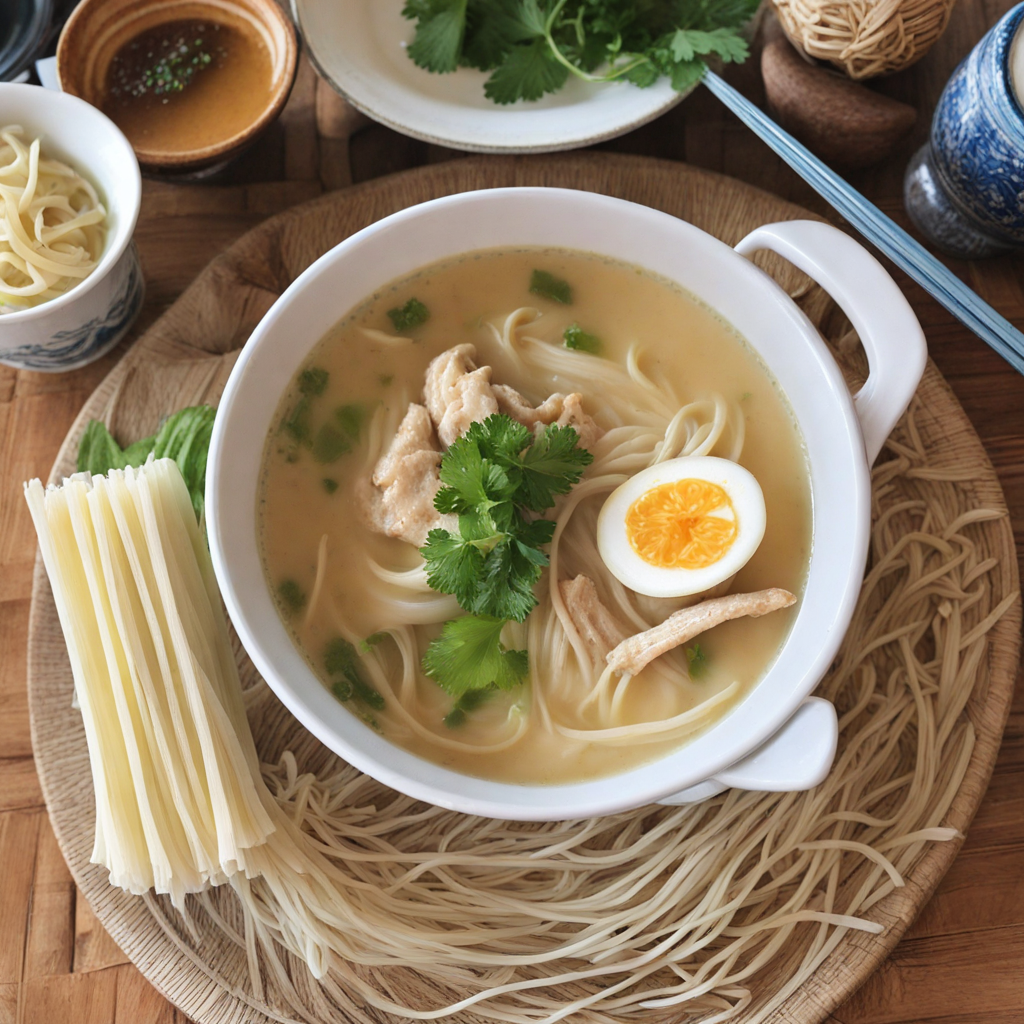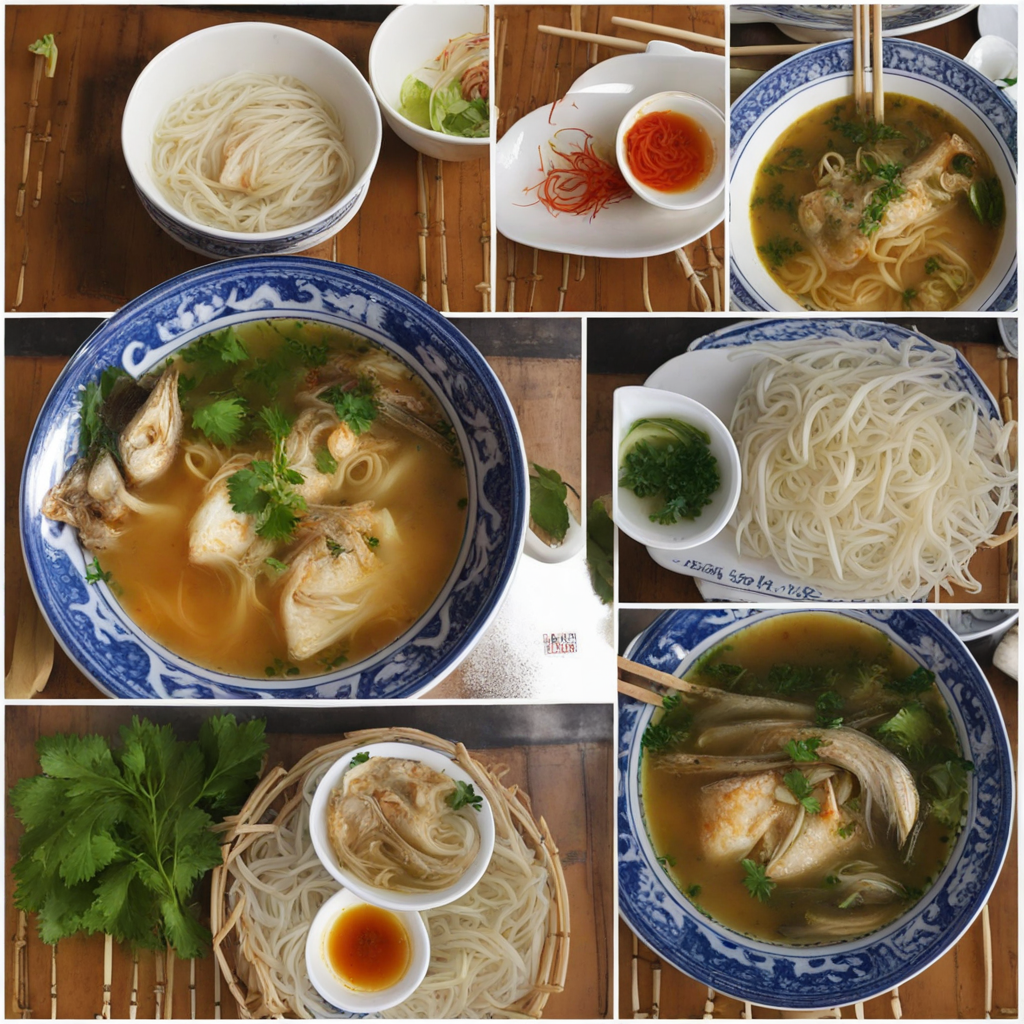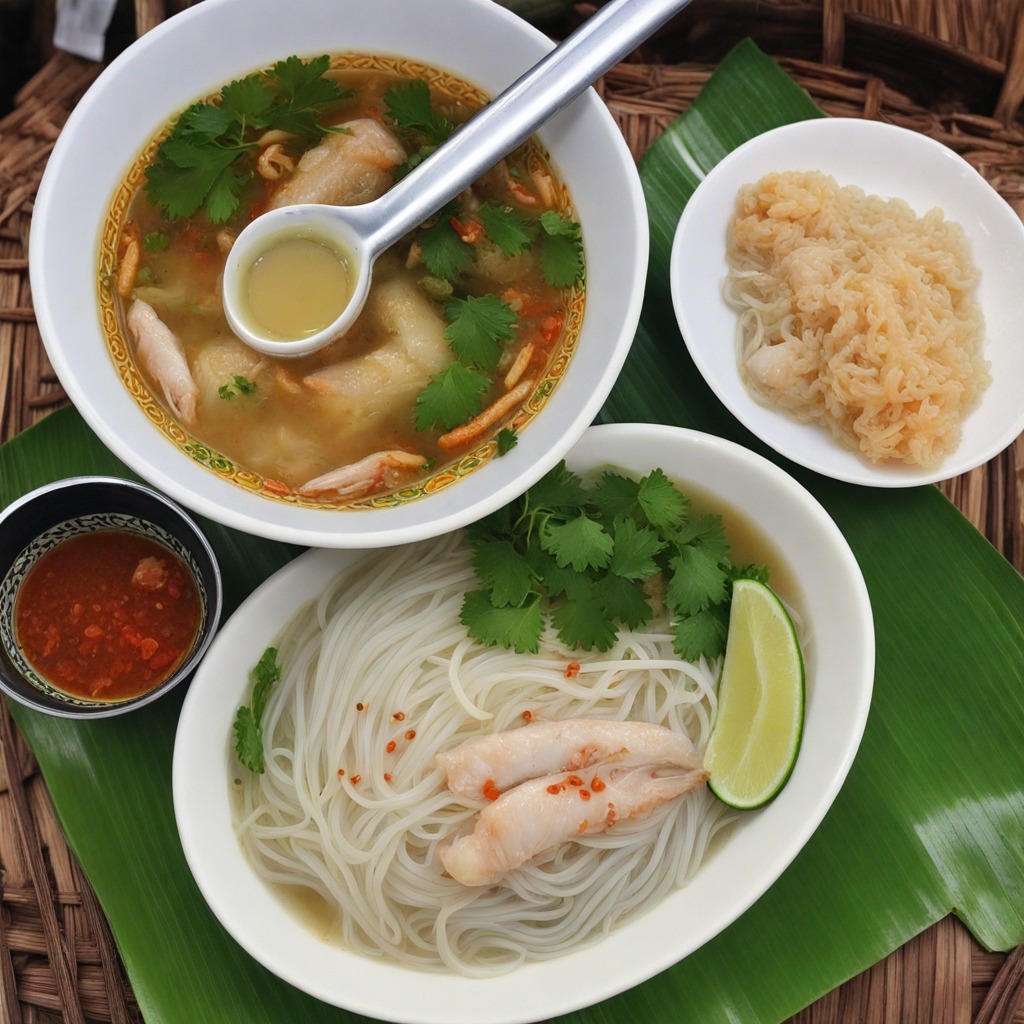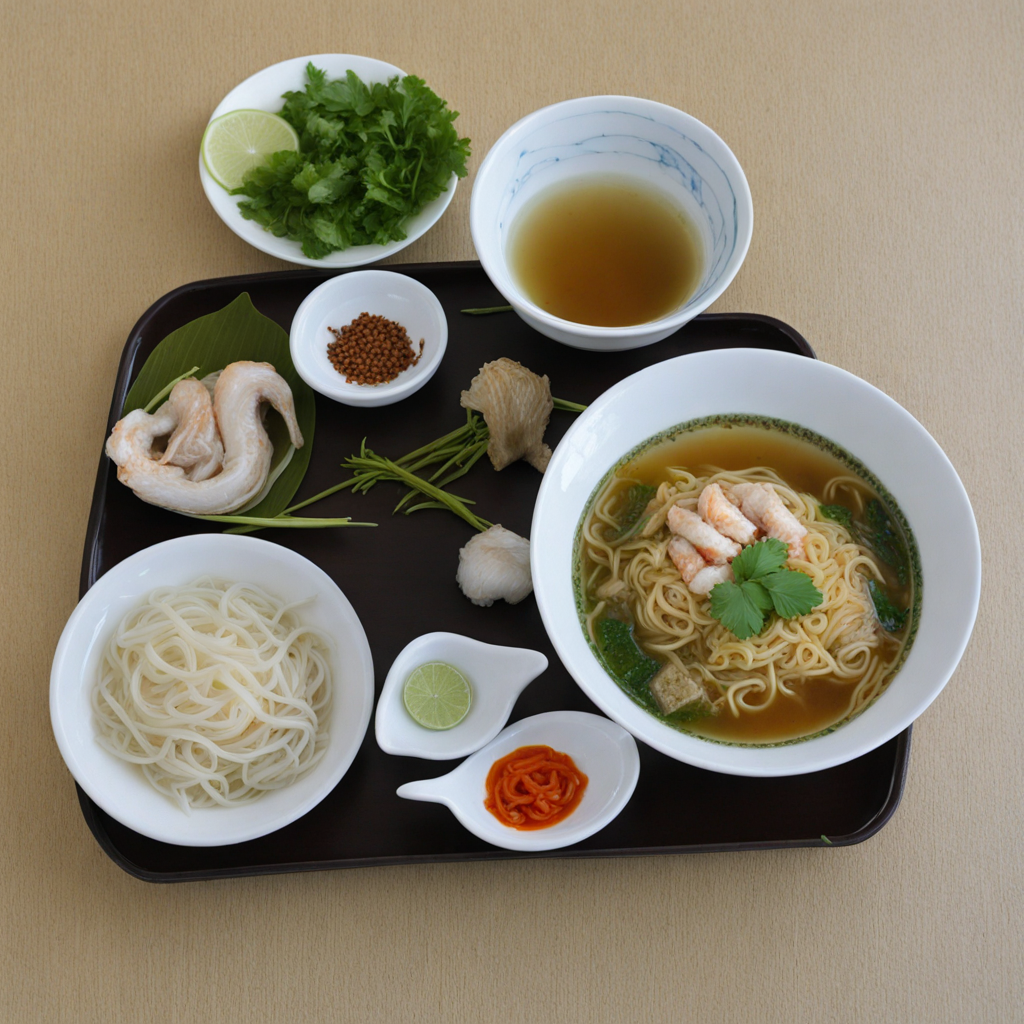Onnokauswe
Onnokauswe is a delightful dish hailing from Myanmar, known for its rich and comforting flavors. This traditional noodle dish typically features thick rice noodles served in a fragrant, creamy coconut milk broth that is both savory and slightly sweet. The broth is often infused with a medley of spices such as turmeric, garlic, and ginger, which not only enhance the taste but also contribute to its warm, golden hue. The addition of chili flakes or fresh chilies brings a gentle heat, making each bite a harmonious blend of flavors that dance on the palate. What sets Onnokauswe apart is its variety of toppings that cater to different tastes and preferences. Common toppings include tender pieces of chicken or beef, hard-boiled eggs, and an assortment of fresh herbs like cilantro and green onions. Crushed peanuts or fried shallots are often sprinkled on top, adding a delightful crunch that contrasts with the softness of the noodles. The interplay between the creamy broth and the various textures creates a satisfying culinary experience that is both hearty and refreshing. Onnokauswe is not just a meal; it is a dish that embodies the warmth of Myanmar's culinary culture. Traditionally enjoyed as a street food staple, it is often served in bustling markets, where vendors expertly prepare it in front of eager customers. Whether enjoyed at a bustling street stall or made at home for a cozy family meal, Onnokauswe offers a unique taste adventure that invites you to explore the rich flavors and traditions of Myanmar, making it a must-try for any food enthusiast.
How It Became This Dish
The History of အုန်းနို့ခေါက်ဆွဲ (Ohn No Khao Swe) from Myanmar Introduction: A Culinary Delight Ohn No Khao Swe, a beloved dish in Myanmar, is a creamy coconut noodle soup that has captured the hearts and palates of locals and visitors alike. This dish is not merely a meal; it embodies the rich tapestry of Myanmar's cultural heritage, showcasing the country's diverse culinary influences and traditions. With its combination of soft wheat noodles, savory chicken, and fragrant coconut milk, Ohn No Khao Swe is more than just a dish; it is a symbol of comfort, community, and celebration. Origins of Ohn No Khao Swe The origins of Ohn No Khao Swe can be traced back to the early 19th century, during the time of the Konbaung Dynasty, when Myanmar was experiencing significant cultural and economic transformations. The dish is believed to have been influenced by the culinary practices of neighboring countries, particularly India, Thailand, and China. The use of coconut milk, for instance, is prevalent in Southeast Asian cuisine, while the incorporation of wheat noodles reflects the influence of Chinese cooking techniques. The name "Ohn No" translates to "coconut milk," and "Khao Swe" means "noodles" in the Burmese language. This duality in the name highlights the primary ingredients and the dish's essence. Initially, Ohn No Khao Swe was a simple meal, often made at home for family gatherings and special occasions. It was a dish that brought people together, fostering a sense of community and shared experience. Cultural Significance Ohn No Khao Swe holds significant cultural importance in Myanmar. It is often served during festivals, weddings, and other important celebrations, symbolizing prosperity and abundance. The dish is particularly popular during the traditional water festival, Thingyan, which marks the Burmese New Year. Families gather to prepare and enjoy this dish, reinforcing bonds and creating memories. Moreover, Ohn No Khao Swe represents the spirit of hospitality that is deeply rooted in Burmese culture. Offering a bowl of this delectable soup to guests is a gesture of warmth and welcome. The dish's versatility also allows for various adaptations, reflecting the regional ingredients and tastes across Myanmar. For instance, variations might include different proteins, such as shrimp or tofu, catering to diverse dietary preferences. Development Over Time As Myanmar underwent various historical changes, Ohn No Khao Swe evolved, reflecting the country's socio-political landscape. The British colonial period in the 19th and early 20th centuries introduced new ingredients and cooking methods, further enriching the dish. The British influence brought about a fascination with curry and spices, which found their way into Myanmar's culinary practices. Ohn No Khao Swe began to incorporate more complex flavors, with the addition of spices like turmeric and ginger, enhancing its taste profile. In the post-colonial era, particularly after Myanmar gained independence in 1948, there was a renewed interest in traditional foods as a means of asserting national identity. Ohn No Khao Swe became emblematic of Myanmar's culinary heritage, celebrated in restaurants and street food stalls across the country. Chefs began to experiment with the dish, introducing unique twists while maintaining its traditional essence. As globalization took hold in the late 20th century, Ohn No Khao Swe found its way into international culinary circles. Burmese expatriates and chefs began to promote this dish abroad, showcasing its rich flavors and cultural significance. Food festivals and cultural events in countries with significant Burmese communities contributed to the dish's rising popularity. Today, Ohn No Khao Swe is not only a staple in Myanmar but is also gaining recognition in international cuisine, often featured in food blogs, cooking shows, and culinary competitions. Cooking and Ingredients The preparation of Ohn No Khao Swe is a labor of love, requiring attention to detail and a blend of flavors. The key ingredients include wheat noodles, coconut milk, chicken (or other proteins), and a variety of spices. The noodles are typically boiled and then served in a rich, aromatic broth made from simmered chicken, coconut milk, garlic, and onions. The use of fresh herbs, such as cilantro and green onions, adds a fragrant touch that enhances the overall experience. The dish is often garnished with a sprinkle of crispy fried onions, a drizzle of chili oil, and a squeeze of lime, offering a delightful contrast of textures and flavors. This layering of tastes is a hallmark of Burmese cuisine, where balance and harmony are key principles. Modern Adaptations and Global Influence In recent years, Ohn No Khao Swe has seen modern adaptations that cater to changing dietary preferences and a global audience. Vegan and vegetarian versions have emerged, replacing chicken with mushrooms or tofu while retaining the rich coconut broth that defines the dish. This adaptability has allowed Ohn No Khao Swe to remain relevant in a rapidly changing culinary landscape. Social media has played a crucial role in the dish's resurgence and popularity, with food enthusiasts sharing recipes, cooking videos, and personal stories associated with Ohn No Khao Swe. The dish's visual appeal, with its vibrant colors and textures, makes it a popular choice for food photography, further amplifying its presence online. Conclusion: A Dish of Love and Legacy Ohn No Khao Swe is more than just a bowl of noodles; it is a culinary journey that connects people to their roots and traditions. Its rich history reflects the diverse influences that have shaped Myanmar's culture while highlighting the importance of community and celebration. As this dish continues to evolve and adapt, it remains a cherished symbol of Myanmar's gastronomic heritage, inviting both locals and visitors to savor its warmth and flavor. In a world where food often transcends borders, Ohn No Khao Swe stands as a testament to the power of culinary traditions to foster connections, celebrate heritage, and create lasting memories. Whether enjoyed at a family gathering or a street food stall, this delightful dish represents the heart and soul of Myanmar, reminding us that food is not just sustenance but a reflection of culture, love, and community.
You may like
Discover local flavors from Myanmar







